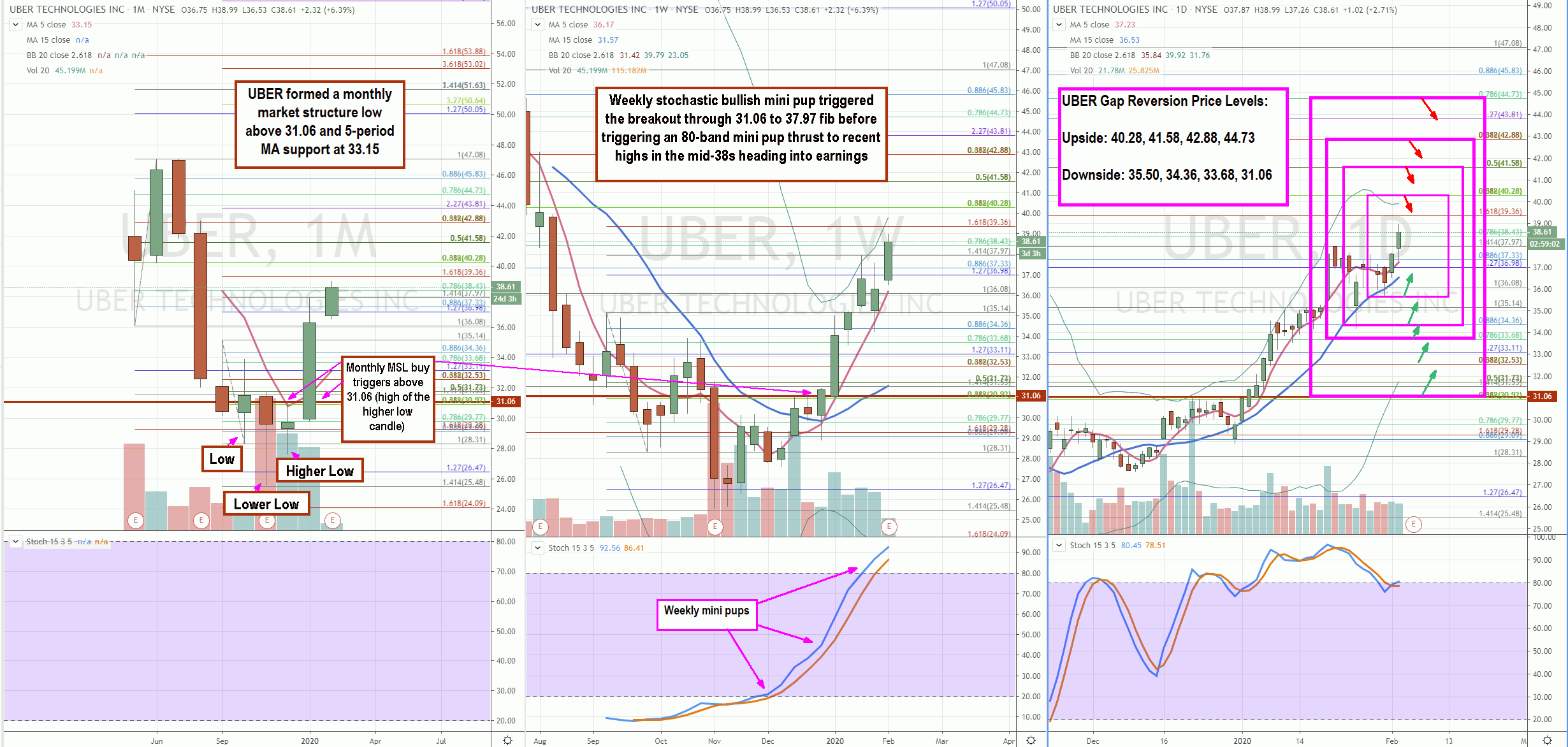Rideshare unicorn
Uber, Inc. (NASDAQ: UBER) reports Q4 2019 earnings after the close on Thursday, Feb. 6, 2020. Analysts expect losses of ($0.52) earnings per share (EPS) on revenues of $4,045 billion.
Improving take-rates at the cost of driver pay cuts ultimately led to the passage of California Assembly Bill 5 (AB5) law also referred to as the gig-worker law. It will require Uber drivers to be classified as employees as it redefines what constitutes an independent contractor. Uber has pledged to fight AB5 along with peers Lyft, Inc. NASDAQ: LYFT , DoorDash and PostMates. They’ve modified the driver app (in California) to accentuate the independence of drivers (IE: rollback of surge multiplier, upfront payout information and drivers setting their own rates). Due to the multi-modal nature of its platform, Uber portends to be a technology company, not a transportation company. Investors will want more visibility on Uber’s “path to profitability”, improved booking numbers, impact and ripple effects of AB5, autonomous cars and any improvement in the cash burn. While Uber sold its UberEATS India subsidiary last quarter, investors are bracing for further shocking loss figures. Despite all the negative press, sentiment has taken a dramatic bullish reversal after bottoming at 25.58 on poor Q3 2019 earnings. The bounce accelerated after former CEO Travis Kalanick reportedly sold out of all his remaining shares. How the narrative affects sentiment will be the deciding factor as to whether the earnings release becomes a sell-the-news event or fuel a sustained recovery back up towards IPO pricing levels.
Macro Context and Influences
The S&P 500 ETF NYSEARCA: SPY is our macro market indicator. SPY has rebound from recent panic lows of 320.74 set last week on Coronavirus fears, weak Chicago PMI and the inverse yield curve. The daily stochastic has crossed up on the SPY. The triple fib range sits at the 331.15 (1.618 fib), 328.12 (1.414 fib) and 326 (super fib).

Technical Analysis
Utilizing the rifle charts, Uber shares have been in a solid recovery since triggering the monthly market structure low (MSL) on the breakout through 31.06 fueled by the weekly stochastic mini pup. The breakout took three tries (three-weeks) before finally cracking and short-squeezing to the weekly upper Bollinger Bands (BBs) at the 37.97 Fibonacci (fib) level. Reversion kicked in back down through the 5-period MA to bounce off the 34.36 fib and coil back up through the 5-period MA thereby triggering another weekly mini pup this time through the 80-band stochastic as it overshoots the 38.43 fib. The daily charts coincide with the weekly charts by triggering mini pups and a final pup breakout on the stochastic crossover back up through the 80-band targeting both weekly and daily upper BBs near the 40.28 super fib. The question is whether upside earnings surprise is already priced into the shares heading into earnings.
Sympathy Stocks:
The single direct sympathy stock is the number two rideshare player Lyft, Inc. NASDAQ: LYFT. Traders and investors will use Uber’s results as a lens into Lyft’s business, notably on any visibility on the core rideshare business and impact of AB5. The latter is especially material to Lyft since it’s a pure-play domestic rideshare stock without additional subsidiaries involving transport, meal delivery, financial products and contracting services like Uber.
Trading Game Plan:
Uber reports earnings after the close on Thursday, Feb. 06, 2020. If Uber shares dump hard on the initial release, look for reversion bounces off the lower envelope ranges heading into the conference call at 5:00pm EST. The same may apply on sharp gaps up, however, be aware of the potential short-squeeze magnet towards the $45 IPO price level. The upside gap reversion price levels (short-sell) are 40.28 weekly/daily upper BBs and super fib, 41.58 fib, 42.88 super fib and 44.73 fib and sticky 5s zone. The downside gap reversion price levels (buy long) are 35.50 sticky 5s zone, 34.36 fib, 33.68 fib, 32.53 sticky 2.50s and overlapping fib and 31.06 the original monthly MSL trigger price level. There are additional fib levels in between, but these are the likeliest reversion levels placed far enough away so the wiggle is limited. Scaling is the best practice for entry and exits with wiggle room up to 30-cents.
Reversion levels can be enveloped for the morning session at the opening bell. Scalp gains can range from 25-cents to 75-cents right off the open and then shrink as the day wears on. Reversion trading is meant for quick scalps playing the second reaction on the gap patterns. Don’t get complacent giving up quick profits on the second reaction only to get trapped by the third and trending reaction, especially if it turns into a slow grind. Seasoned traders can also look to play the sympathy reactions on LYFT, which trades at a higher price and tends to have larger price swings. As for leadership, these two tend to flip flop depending on which has news or is making intraday highs or lows.
Before you make your next trade, you'll want to hear this.
MarketBeat keeps track of Wall Street's top-rated and best performing research analysts and the stocks they recommend to their clients on a daily basis.
Our team has identified the five stocks that top analysts are quietly whispering to their clients to buy now before the broader market catches on... and none of the big name stocks were on the list.
They believe these five stocks are the five best companies for investors to buy now...
See The Five Stocks Here
Unlock your free copy of MarketBeat's comprehensive guide to pot stock investing and discover which cannabis companies are poised for growth. Plus, you'll get exclusive access to our daily newsletter with expert stock recommendations from Wall Street's top analysts.
Get This Free Report
Like this article? Share it with a colleague.
Link copied to clipboard.